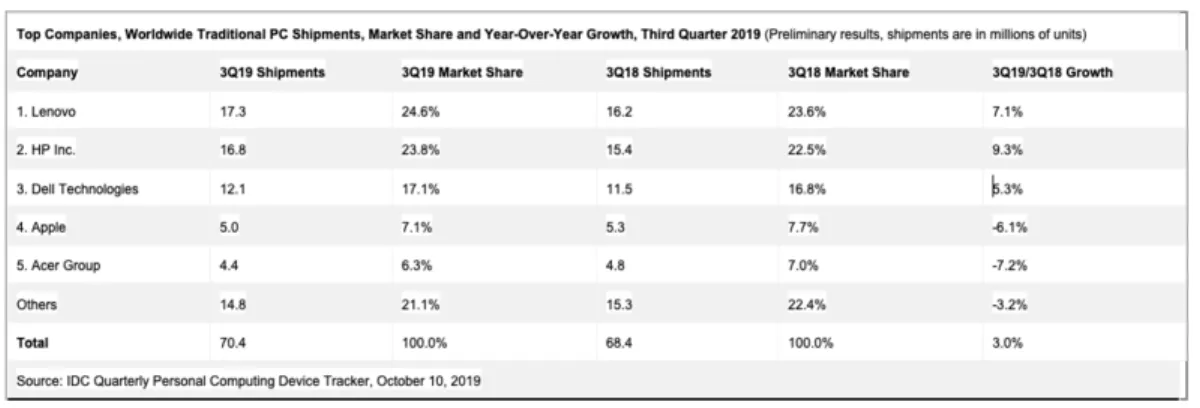
Traditional PC market continues growth despite issues in the supply chain
Despite issues with the supply chain, the global traditional PC market is continuing to grow. While traditional PC shipments in Asia/Pacific (excluding Japan) posted a year-over-year decline, the market performed above expectations.
Meanwhile, nearly one of every four PCs shipped during the quarter were from Lenovo or one of its subsidiaries as the company once again managed to hold the top position in the market.
According to new figures from IDC's Worldwide Quarterly Personal Computing Device Tracker, worldwide shipments of traditional PCs, comprised of desktops, notebooks, and workstations, reached 70.4 million units in the third quarter of 2019 (3Q19).
The analyst firm says demand in the commercial segment combined with trade tensions between the United States and China are driving the market forward, resulting in a second consecutive quarter of growth with shipments increasing by 3% over the third quarter of 2018.
"With higher tariffs on the horizon PC makers once again began to push additional inventory during the quarter though the process was a bit more difficult as many faced supply constraints from Intel, leaving AMD with more room to grow," explains Jitesh Ubrani, research manager for IDC's Mobile Device Trackers.
"The trade tensions are also leading to changes in the supply chain as most notebook manufacturers are now prepared to move production to other countries in Asia, such as Taiwan and Vietnam," he says.
Linn Huang, research vice president, devices - displays, says commercial demand should accelerate as enterprises work through the remainder of their Windows 10 migration.
"The number of months until the end of service (EOS) date of Windows 7 can be counted on one hand," Huang says.
"With January 14, 2020 drawing nigh, the commercial market should be able to digest the extra inventory over the next several quarters. Supply constraints may loom in subsequent quarters, so excess may not be a bad position for channel inventory through the remainder of the year."
Regional Highlights
Traditional PC shipments in Asia/Pacific (excluding Japan) posted a year-over-year decline but the market performed above expectations.
Back-to-school demand drove the consumer market in China, while online sales and preparations for the Diwali festive season supported consumer shipments in India, as two of the largest countries in the region surpassed the previous forecast. Meanwhile, the commercial market in China recorded a decline in line with expectations, impacted by macroeconomic pressures.
Coming in slightly above forecast, the Canadian traditional PC market delivered its 13th consecutive quarter of growth. The market is becoming increasingly solidified as the top 5 vendors now capture more than 85% of all shipments.
In Europe, Middle East and Africa (EMEA), the traditional PC market achieved stable growth in 3Q19 with both desktops and notebooks performing relatively well. A strong pipeline of deals ahead of the ongoing Windows 10 transition continued to translate into commercial strength, offsetting the softness in the consumer market and the overall negative impact of the component shortage.
In Japan, both the commercial and consumer markets largely outperformed forecast, driven by Windows 10 migration and the consumption tax increase respectively. Commercial shipments established a new third quarter record beating the mark set in 2013 when Windows XP EOS created similar momentum in the commercial PC market.
The traditional PC market in Latin America was very much in line with previous expectations of a 4.1% year-over-year decline. During this period desktop shipments were better than expected mainly due to the large enterprise segment and verticals such as banking, retail, and manufacturing. Notebook shipments also declined during the quarter due to a weak consumer market and delays in some education deals.
The United States saw low single-digit growth in the third quarter with both desktop and notebooks seeing continued year-over-year growth. Inventory pull-in continued to be supported by Windows 7 EOS and continued tensions in the trade war. As most List 4 tariffs have been delayed until the end of the year, inventory pull-in overall was slightly weaker compared to the previous quarter. According to a recent survey among IT decision makers in the USA, more than 60% of businesses have transitioned their Windows-deployed PCs from Windows 7 to Windows 10. Another 13% plan to do so by the Windows EOS date in January 2020.
Company Highlights
Nearly one of every four PCs shipped during the quarter were from Lenovo or one of its subsidiaries as the company once again managed to hold the top position in the market. The company's strong push in EMEA and Japan, along with a notable commercial presence, helped cement it as the leader during the quarter.
HP Inc. was a close second with 16.8 million PCs shipped during the quarter and the fastest year-over-year growth among the top 5 companies. The company's notebook lineup in particular has been quite strong with 10% year-over-year growth beating the overall rate of 4% for notebooks.
Dell Technologies ranked third, shipping 12.1 million units with 5.3% growth over the previous year. Its strong portfolio of commercial-centric products and a very healthy gaming business has helped the company keep its year-over-year growth streak going since the second quarter of 2016.
Apple refreshed its MacBook Air and Pro and benefited from the back-to-school season to achieve 21% growth over 2Q19. Overall the company still struggled to maintain positive momentum on a year-over-year basis as it continued to face supply constraints.
Acer Group rounded out the top 5 while facing the strongest decline among the top 5. The shortage of Intel processors impacted the company although it still continues to be one of the stronger players in the gaming and Chromebook segments.



